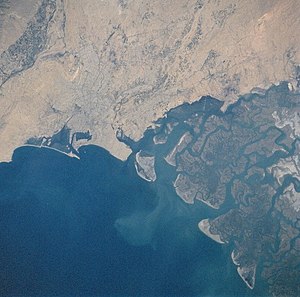| Revision as of 04:09, 25 September 2004 editBerkut (talk | contribs)Extended confirmed users2,384 editsm spelling correction← Previous edit | Revision as of 09:45, 28 September 2004 edit undo203.175.66.11 (talk) This is the wrong place to advocate the Biltistani POV and/or their sentiments however noble and just they might beNext edit → | ||
| Line 1: | Line 1: | ||
| ], near the rock Aornus.]] | ], near the rock Aornus.]] | ||
| The '''Indus''' (known as '''Sindhu''' in ancient times) is the principal ] of ]. It flows from the ], a famous mountain in the ] region, which is also known as the ] and goes through out Pakistan and finally meets the ] in the ] province and is interestingly named after it, not the original source the ]. |
The '''Indus''' (known as '''Sindhu''' in ancient times) is the principal ] of ]. It flows from the ], a famous mountain in the ] region, which is also known as the ] and goes through out Pakistan and finally meets the ] in the ] province and is interestingly named after it, not the original source the ]. | ||
| Once upon a time there existed an ] and then was ruined by time. It was one of the oldest urban civilizations in the world. The ultimate source of the Indus is actually in ]; it begins at the confluence of the ] and ] that drain the ] and ] ranges. The Indus then flows northwest through ] just south of the ] range, then gradually bends to the south, coming out of the hills between ] and ]. It is dammed in this area also, forming the ]. The remainder of its route to the sea is in plains of the ] and ], and the river becomes slow-flowing highly braided. Passing by ], it ends in a large delta to the southeast of ] that has now been recognised by conservationists as one of the world's most important ecological regions. | Once upon a time there existed an ] and then was ruined by time. It was one of the oldest urban civilizations in the world. The ultimate source of the Indus is actually in ]; it begins at the confluence of the ] and ] that drain the ] and ] ranges. The Indus then flows northwest through ] just south of the ] range, then gradually bends to the south, coming out of the hills between ] and ]. It is dammed in this area also, forming the ]. The remainder of its route to the sea is in plains of the ] and ], and the river becomes slow-flowing highly braided. Passing by ], it ends in a large delta to the southeast of ] that has now been recognised by conservationists as one of the world's most important ecological regions. | ||
Revision as of 09:45, 28 September 2004

The Indus (known as Sindhu in ancient times) is the principal river of Pakistan. It flows from the Himalayas, a famous mountain in the Gilgit-Baltistan region, which is also known as the Northern Areas of Pakistan and goes through out Pakistan and finally meets the Arabian Sea in the Sindh province and is interestingly named after it, not the original source the Gilgit-Baltistan.
Once upon a time there existed an Indus Valley Civilization and then was ruined by time. It was one of the oldest urban civilizations in the world. The ultimate source of the Indus is actually in Tibet; it begins at the confluence of the Sengge River and Gar River that drain the Nganglong Kangri and Gangdise Shan ranges. The Indus then flows northwest through Gilgit-Baltistan just south of the Karakoram range, then gradually bends to the south, coming out of the hills between Peshawar and Rawalpindi. It is dammed in this area also, forming the Tarbela Reservoir. The remainder of its route to the sea is in plains of the Punjab and Sind, and the river becomes slow-flowing highly braided. Passing by Hyderabad, it ends in a large delta to the southeast of Karachi that has now been recognised by conservationists as one of the world's most important ecological regions.
The Indus River Dolphin, modern genetic studies show, lives both in the Indus River and in the Ganges. The two populations were formerly considered distinct species. It formerly occurred in the tributaries of the Indus also and may have extended into the northwestern extremities of the Indian Province of Punjab.
The Indus is one of the few rivers in the world that exhibit a tidal bore.
Tributaries:
- Gilgit River
- Gizar River
- Hunza River
- Gumal River
- Zhob River
- Kabul River
- Kunar River
- Sutlej River
- Beas River
- Chenab River
- Jhelum River
- Ravi River
See also:
External Links
- The Changing Northern Areas ]
- Pakistan's Northern Areas dilemma]
- Northern Areas Development Gateway]
- Pakistan's Northern Areas ]
- Northern Pakistan's Karakoram & Hindukush Mountains ]
- The Mountain Areas Conservancy Project ]